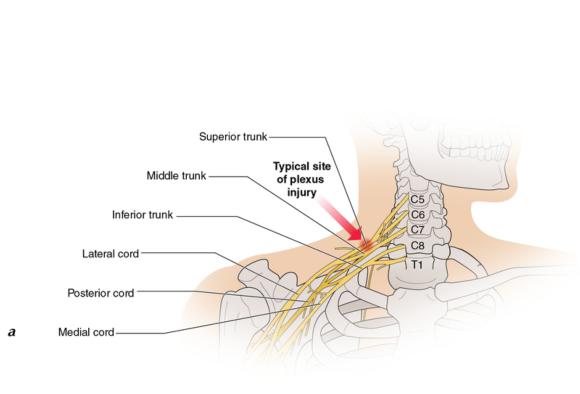| http://www.humankinetics.com/excerpts/excerpts/injuries-to-the-cervical-nerve-root-and-brachial-plexus-neurapraxia |
|
Cervical nerve root and brachial plexus neurapraxia are known by several colloquialisms, such as "burners" or "stingers." Stretching of the upper trunk of the brachial plexus accounts for the majority of these syndromes. Downward traction of the shoulder associated with lateral flexion of the neck to the opposite side is the proposed mechanism of injury in many cases. A similar pattern can be seen with a direct injury to the plexus by an external force applied to the supraclavicular area. The neurologic deficit in almost all of these cases includes the upper portion of the plexus, with weakness of the deltoid, biceps, and shoulder rotator muscles, and numbness extending down to the thumb and index finger (figure 16.4).
Plexus or root injuries. (a) Schematic: brachial plexus. Note its origins from the C5 through T1 nerve roots. UT = upper trunk, formed by a merger of the anterior divisions of the C5 and C6 roots. (b) Mechanisms of plexus versus root injury: The superior position of the upper trunk makes it most vulnerable to direct blows or stretching from distraction of the neck away from the shoulder. In contrast, a root may also be injured by lateral flexion of the neck toward the side of symptoms, associated with foraminal narrowing, especially in the presence of an underlying disc herniation or osteophyte.
Any other pattern of radicular symptoms is more suggestive of an isolated nerve root injury. The C5 and C6 nerve roots are most commonly affected, due to transient neural foraminal narrowing from a compressive axial force. An underlying osteophyte or disc rupture is identified in many of these cases.
|
Read more from Handbook of Neurological Sports Medicine by Anthony L. Petraglia, Julian E. Bailes, and Arthur L. Day.
|
суббота, 27 июня 2015 г.
Injuries to the cervical nerve root and brachial plexus neurapraxia
Подписаться на:
Комментарии к сообщению (Atom)



Комментариев нет:
Отправить комментарий